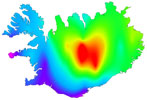Research

Hot spots and mantle plumes
I play a major role in co-ordinating the current global debate on whether deep mantle thermal plumes exist and give rise to “hot spot” volcanism. This has been described as the most important controversy in Earth Science today. A critical element of the subject is development of alternative models. My main activites are:
- I founded and manage the website www.MantlePlumes.org, an international forum for the debate, which currently contains contributions from ~250 scientists and over 300 web pages, ~100 of which are purpose-written scholarly articles.
- I initiated and convened two recent international conferences, Plume IV: Beyond the Plume Hypothesis, a Penrose Conference held in Iceland in 2003 and sponsored by the Geological Society of America, and The Great Plume Debate, a Chapman Conference held in Scotland in 2005 and sponsored by the American Geophysical Union.
- I edited a recent book Plates, Plumes, and Paradigms, published by the Geological Society of America.
Examples of recent significant publications:
- Foulger, G.R., J.H. Natland, D.C. Presnall and D.L. Anderson (Eds.), Plates, Plumes, and Paradigms, Geol. Soc. Am. Special Volume 388, pp. 881+xi, 2005.
- Foulger, G.R. and J.H. Natland, Is “hotspot” volcanism a consequence of plate tectonics?, Science, 300, 921-922, 2003.

The Coso geothermal area is utilized to generate ~250 Mw of electricity. Steam removal induces intense microearthquake activity suitable for advanced seismic analysis techniques that are powerful to monitor the reservoir and optimize production strategies. I have used the ~80,000-earthquake dataset currently available for time-dependent seismic tomography, relative event relocations and moment-tensor analysis.
These studies have yielded a 3D image of the entire reservoir, and show changes in reservoir properties with time caused by production. Fracture enhancement is conducted using hydraulic stimulation to improve steam recoverability. A unique proof-of-concept of the moment-tensor technique to image stimulated fractures and their mode of failure was recently achieved. During 2006, hydraulic stimulations in additional wells will be monitored and studied. The huge dataset available has the potential to generate numerous other studies.
This project is conducted in collaboration with the U.S. Geological Survey, the U.S. Navy and the University of Utah, and is funded in part by the Department of Energy. It comprises a strategic element in the development of alternative energy resources.
Examples of recent significant publications:
- Julian, B.R., G.R. Foulger, K. Richards-Dinger and F. Monastero, Time-dependent seismic tomography of the Coso geothermal area, 1996-2004, Proceedings, Thirty-First Workshop on Geothermal Reservoir Engineering, Stanford University, Stanford, California, January 30-February 1, 2006.
- Foulger, G.R., B.R. Julian, D.P. Hill, A.M. Pitt, P. Malin and E. Shalev, Non-double-couple microearthquakes at Long Valley Caldera provide evidence for hydraulic fracturing, J. Volc. Geotherm. Res., 132, 45-71, 2004.

The Iceland Hotspot Project
In 1996 I led a multinational, NERC-, NSF- and EC-funded consortium that deployed in Iceland the largest regional broadband seismometer network ever installed in the world at the time. Over a two-year period it returned several hundred Gbyte of seismic data that are now publicly available on the Internet. These data have fueled, and continue to fuel, numerous research projects and Ph.D. theses.
Major discoveries include the shallow nature of the low-velocity mantle anomaly beneath Iceland and an extensive low-velocity body in the crust that may represent a submerged oceanic microplate. Seismic velocity anisotropy suggests ridge-parallel flow; the absence of the predicted radial pattern is consistent with the lack of radial coherence in surface geochemistry.
The results have generated numerous published papers and furthered understanding of hot spots globally. The unexpected complexities revealed raise many new questions, inspiring a wealth of further topics for study, including graduate-student theses.
Examples of recent significant publications:
- Du, Z., L.P. Vinnik and G.R. Foulger, Evidence from P-to-S mantle converted waves for a flat “660-km” discontinuity beneath Iceland, Earth Planet. Sci. Lett., 241, 271-280, 2006.
- Foulger, G.R., Z.J. Du and B.R. Julian, Icelandic type crust, Geophys. J. Int., 155, 567-590, 2003.

It is commonly assumed that earthquakes are caused by shear motion on geological fault planes. Such motion is expected to generate seismic source mechanisms consisting of two mutually orthogonal force couples, the so-called “double couple” model. For several decades, this model was used as an a-priori assumption to constrain seismic data interpretation.
Working in the Hengill geothermal area, Iceland, I achieved the first observation of earthquakes whose sources unambiguously involved an explosive, crack-opening component in addition to shear. Such sources can be explained by the motion of fluids, e.g., magma or water, into cracks – a process fundamental to the hydraulics of volcanoes and geothermal areas. This work has relevance to volcanic hazard reduction and geothermal resource utilization.
I have applied the results to active volcanoes in Iceland and the USA, and to geothermal areas in Iceland, the USA, Indonesia and Papua New Guinea. This research theme has generated many field projects, publications and Ph.D. theses. I presently apply the methods developed to the Coso geothermal field, southern California.
Examples of significant publications:
- Julian, B.R., A.D. Miller and G.R. Foulger, Non-double-couple earthquakes 1. Theory, Rev. Geophys., 36, 525-549, 1998
- Miller, A.D., G.R. Foulger and B.R. Julian, Non-double-couple earthquakes 2. Observations, Rev. Geophys., 36, 551-568, 1998
- Foulger, G.R., R.E. Long, P. Einarsson and A. Bjornsson, Implosive earthquakes at the active accretionary plate boundary in northern Iceland, Nature, 337, 640-642, 1989
- Foulger, G. and R.E. Long, Anomalous focal mechanism solutions: evidence for tensile crack formation on an accreting plate boundary, Nature, 310, 43-45, 1984

Crustal deformation using the Global Positioning System
In the period 1986 – 1995 I led 7 multinational GPS surveys in Iceland, Turkey and the Basin & Range Province, western USA. These surveys involved teams of up to ~20 fieldworkers who occupied up to ~100 survey stations distributed over regions up to ~800 km wide. The objectives were to establish and measure networks of survey points to centimetre-level accuracy, and then to re-measure them in order to constrain crustal deformations due to geological processes. This huge surveying effort, and the massive data-processing and software-development effort required to extract the results, led to several major discoveries.
A great dyke-injection episode along the spreading plate boundary in Iceland 1975-1985 loaded the crust with stress, which was subsequently gradually released by slow deformation that continued at a detectable level until 1995. Our observation of this phenomenon remains a unique achievement and enabled us to calculate the viscosity of the asthenosphere. Surveying across the Basin & Range Province revealed that most of the ~1 cm/year of expansion there is concentrated in two seismically hazardous zones.
The project generated significant papers, M.Sc. and Ph.D. theses and post-doctoral projects. It laid the groundwork for ongoing investigations of the study regions that continue to the present day.
Examples of significant publications:
- Thatcher, W., G.R. Foulger, B.R. Julian, J. Svarc and E. Quilty, Present day deformation across the Basin and Range Province, western United States, Science, 283, 1714-1718, 1999
- Foulger, G.R., C.-H Jahn, G. Seeber, P. Einarsson, B.R. Julian and K. Heki, Post rifting stress relaxation at the accretionary plate boundary in Iceland, measured using the Global Positioning System, Nature, 358, 488-490, 1992
last update 22nd January, 2009
